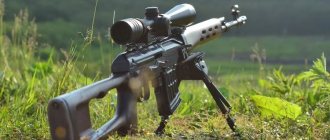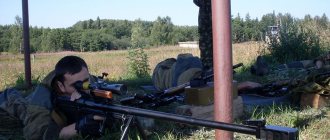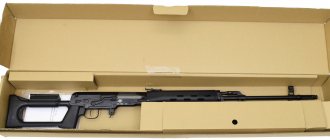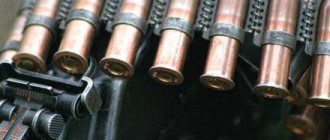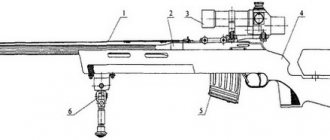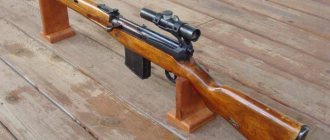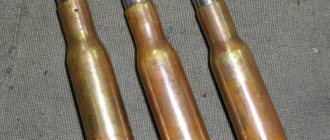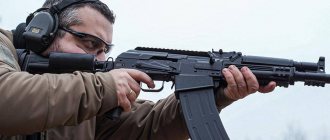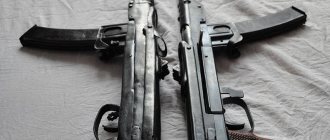Carbine KK Record 338LM sb-06
Caliber: The caliber of a rifle is measured by the distance between opposite fields, or by the distance between the bottom of opposite ones.
In the USA, Great Britain and other countries it is indicated in fractions of an inch (.308 Winchester; in the USA - in hundredths (0.45 inches), in the UK - in thousandths (0.450 inches).
In other countries it is measured in millimeters - 9×18
(first number, 9 - caliber, second, 18 - length of the sleeve in millimeters). It must be taken into account that cartridges of the same caliber can be of different lengths.
Operating principle: With a longitudinally sliding bolt - this type ensures the opening and closing of the barrel by moving the bolt along the axis of the barrel. The mechanism is popular due to the fact that the bolt in it can easily be used as the main driving force for activating other weapon mechanisms - feeding cartridges, removing spent cartridges and others, thereby ensuring simplicity and rationality of the design of the weapon, creating the best conditions for reloading and layout weapons in general.
Inertial principle - a weapon in which automatic action is achieved by using the recoil energy generated when firing;
The gas principle is a weapon in which the automation is driven by the pressure of powder gases.
A fitting is a gun with a break barrel. Fittings usually have two barrels, but there are single-barrel and less often three-barrel. The advantage of the fitting compared to a magazine carbine is the ability to quickly fire a second shot without wasting time on jerking the bolt.
No less important is the greater reliability of the fitting, since in the event of a misfire on the first shot, you can immediately, without delay, shoot from the second barrel.
Henry Brace - a principle of operation in which moving the Henry reloading bracket downward and forward allows the locking wedge to be lowered. Moving the bracket in the rear and upward directions allows the bolt to send the next cartridge into the barrel from the magazine, then the wedge rises up, installing itself in a cutout in the rear of the bolt, locking it. Feeding is carried out by an integral box magazine, in which the cartridges are arranged in a single row; the cartridges are loaded and the spent cartridges are ejected as a result of the open bolt through the upper window of the receiver.
Carbine KK Record 338 Lapua Magnum sb-06 in the World of Hunting online store
The 338 caliber rifled hunting carbine KK Record 338 Lapua Magnum sb-06 is designed for commercial hunting of medium and large game at ambient temperatures from minus 50 to plus 50 °C.
This Kalashnikov Concern rifle consists of the following assembly units: barrel with receiver, bolt assembly, stock assembly, magazine assembly, trigger mechanism, bipod assembly. When supplied with an optical sight, the carbine also includes an optical sight with a bracket.
Hunting carbine Record
The hunting rifle in question was created specifically for shooting large and medium-sized animals. The ammunition used for this carbine is a 9x53 centerfire hunting cartridge, which was developed somewhat earlier. The diameter of the bullets is 9.27 millimeters, which is in absolute compliance with the standard applicable for European-made cartridges.
The bullet is made on the basis of a semi-shell design, in which the lead core is exposed in the head part, its weight is 15 grams. As for the speed of such a bullet, it is initially about 680 meters per second with its average dispersion not exceeding 8 centimeters (at a range of 100 m). The total length of the cartridge is 67 mm, the length of the sleeve is 53 mm.
Main characteristics
The characteristics that the “Record” hunting carbine has are very optimal, in particular the following should be highlighted:
- weight, excluding the optical sight and bracket, is about 3.1 kilograms. It is worth noting that this particular weight will be very convenient for moving through mountainous areas and swamps, since it does not pose much difficulty for the average hunter.
- The total length of the carbine is 1060, which is quite a high figure for moving through the bushes, but it is worth remembering that the longer the gun, the easier it will be to aim.
- 550 mm carbine barrel length.
- Aimed fire from the “Record” can be carried out at 470 meters, which cannot be ignored when hunting heavier game and goose, which is why this model is so popular among hunters in the taiga.
- 6 right-hand rifling barrel;
- cutting pitch length – 320 mm;
- integral magazine design used for 5 cartridges, which are placed in a checkerboard pattern (3 magazines are supplied with the gun from the factory).
The stock of the Record hunting carbine is created in a traditional form for a pistol with the obligatory presence of a protrusion for the cheek. There is a rubber-based shock absorber on the butt plate; the box is attached directly to the barrel using a threaded connection. The rear sight and front sight are placed on the sighting bar, forming a single whole. This bar contains numbers (1-5), which determine the correspondence to the aiming range of the shot at a distance of one hundred to five hundred meters. The required range is set by the hunter by moving a clamp specially designed for this purpose, which is placed on the sight rail; simplicity is the key to a successful hunt. You can install it in a hunting “Record” using a special bracket, an optical sight, which in most cases is designed for fourfold magnification. The diameter that ensures the average dispersion of bullets, as a rule, does not exceed 8 cm in size at a shot range of 100 meters. The shutter, which provides the Record carbine, is equipped with a mainspring, as well as a firing pin. It has a longitudinally sliding design with rotation when locked. Using a flag-type fuse, rotation of the shutter with the trigger is blocked. The Record carbine also has the ability to adjust the trigger force in the range from 1 to 1.5 kgf, as well as adjust the amount of travel it makes (with or without warning). The hunting rifle in question has proven to be convenient and trouble-free in operation under various climate conditions characteristic of our state. It comes complete with a belt used for carrying, a case, and various accessories that can be used to disassemble, clean and lubricate the carbine. The carbine is cleaned after each use of the gun, but even otherwise the gun is very resistant to dirt.
Russian sniper rifle SV-338
In 2013-2014, the Kalashnikov Concern, taking into account the experience gained when creating the SV-98 sniper rifle, developed the SV-338 sniper rifle chambered for the .338 Lapua Magnum cartridge.
Tactical and technical characteristics of the SV-338: Caliber - 8.6 mm; Cartridge - .338 Lapua Magnum Length - 1235 mm; Length with muffler – 1390 mm; Barrel length – 700 mm; Bore rifling - 6 Initial bullet speed - 905 m/s; Weight without optical sight - 5.9 kg; Weight with optical sight and silencer - 8.2 kg; Magazine capacity - 5 rounds. Sighting range - up to 1500 m.
Sniper rifle Record-338
The SV-338 sniper rifle is a military version of the Record-338 sporting rifle. The weapon is equipped with a longitudinally sliding bolt. The selected caliber - .338 Lapua Magnum - allows you to confidently hit with high accuracy at a distance of 1 km or more targets protected by personal armor protection (PIBZ). The SV-338 magazine is designed for 5 rounds.
Sniper rifle SV-338
The SV-338 sniper rifle has a mount for optical sights of the Picatinny standard, which allows the use of both domestic and foreign models. The rifle is equipped with an adjustable stock with an integrated stop. A muzzle brake-compensator can significantly reduce recoil.
The SV-338 sniper rifle will be in demand both by the Russian armed forces and special units. At the moment, a corresponding application has been submitted and work is underway to prepare permits for the export of these weapons.
Sniper rifle SV-338 disassembled
SV-338 sniper rifle in a firing position
Sniper rifles SV-338 and SVDS
"Three-three-eight" in Russian
Today, the .338 caliber has become a true standard for precision sniper rifles around the world. In Russia, the creation of a domestic analogue resulted in a series of difficulties that were not immediately overcome.
From forests to landfills
The first .338 caliber (8.6 mm) cartridges were created in the 80s by order of the US Department of Defense for a new sniper rifle. Promising ammunition was supposed to have sufficient penetrating effect against manpower protection equipment at a distance of 1000 m. Then the developers were unable to achieve the required characteristics due to the use of a hunting cartridge in the design of the cartridge case.
Later, the Finnish company Lapua modified the cartridge case and in the late 80s released a sporting and hunting cartridge on the commercial market under the designation .338 Lapua Magnum. The 8.6×69 mm cartridge made it possible to fire rifles at a distance of up to 1500 m. Soon a number of well-known arms factories began to produce sniper rifles chambered for the new cartridge, and 8.6 mm weapons appeared among snipers in special forces units. The successful use of the new sniper system in the operations of the coalition of international forces in Afghanistan and Iraq contributed to the rapid spread of three-three-eight caliber rifles around the world. In November 2009, British sniper Craig Harrison, using an 8.6 mm L115A3 rifle, set a documented record for the distance to engage an enemy at a distance of 2475 m. This result remains a record in its class, later losing the palm only to the larger caliber 12.7 mm .
Sniper cartridges developed by TsNIITOCHMASH V. Kuzmin
The first Russian high-precision long-range cartridge was also born on the basis of hunting ammunition. The “donor” for it was the Soviet hunting cartridge 9.3x64 mm, intended for hunting large animals weighing up to 500 kg. In the 90s, when developing a new sniper cartridge, the Central Research Institute of Precision Engineering (TSNIITOCHMASH) again returned to its early “civilian” developments. Having followed the path of American developers, Russian engineers stepped on the same rake, when a smooth transition from “hunting the beast” to specific military tasks was doomed to failure. Nevertheless, TsNIITOCHMASH specialists brought their work to its logical conclusion, delivering the required product to the customer as part of the development work (R&D) “Vzlomshchik-9”.
"Burglar-9"
In March 1998, the Main Rocket and Artillery Directorate (GRAU) opened the Vzlomshchik-9 R&D project to develop a 9-mm sniper complex to replace the 7.62-mm complex with the SVD rifle, ensuring an increase in firing efficiency by 1.3-1.5 times . The requirements for the complex were repeatedly adjusted and clarified; in the final version, the probability of hitting a target wearing a 6B23 body armor with the first shot at 500 m was at least 80%.
The production of the 9-mm rifle cartridge was entrusted to the Novosibirsk Cartridge Plant, and the Izhevsk Machine-Building Plant (Izhmash) began manufacturing ballistic barrels. It was then that it became clear that new live cartridges could easily be used in hunting weapons. To meet the requirements of the Weapons Law, the rifling pitch for the sniper rifle was reduced from 365 to 295 mm. The Novosibirsk Central Design Bureau "Tochpribor", the Krasnogorsk Mechanical Plant and the Kazan Design Bureau "SCAN" were ordered to provide the complex with sighting devices.
Comparison of 9-mm and 7.62-mm sniper systems Kalashnikov Magazine
In addition to the manufacture of ballistic barrels, Izhmash was developing a self-loading sniper rifle. Izhevsk also took the path of least resistance, taking the design of the well-known SVD as the basis for the future rifle. For the new rifle, a receiver, bolt frame and bolt similar to the SVD type were designed, but of increased dimensions, as well as a suspended barrel and a removable bipod. The rifle with the SN sniper cartridge received a 1.5-2 fold advantage in combat effectiveness over the standard SVD with the 7N14 cartridge. In addition, the 9-mm sniper cartridge ensured penetration of 10-mm armor plate at a range of 100 m.
To improve the accuracy of the rifle's fire, it was decided to first return to a rifling pitch of 365 mm, increasing their number to 6, and then return to 4 rifling again, but with a pitch length of 390 mm. Problems during testing arose not only with the rifle, but also with cartridges and optical instruments. Field tests of the 6B9 rifle were completed only in May 2003. The commission’s conclusion stated that “the 6S7 9-mm sniper complex does not fully satisfy the requirements of the technical specifications and, before being submitted for state testing, must be improved in terms of operational reliability and survivability of rifle parts and in cutting sights for the refined ballistics of the 7N33 cartridge.”
.
Rifle 6B9 V. Simonenko
From 2004 to 2005, state tests were carried out, for which two versions of sniper rifles with 4x390 mm and 6x365 mm rifling were presented. Based on the test results, 4x390 mm rifling, which showed slightly better accuracy, was recommended for further testing, and the 9-mm 6S7 sniper complex, which met the requirements of the GRAU technical specifications, was recommended for adoption.
The 6V9 rifle, 7N33 cartridge, 1P70 and 1PN101 sights were adopted into service by the Russian army only in 2013. However, by this time, foreign and Russian rifles chambered for the standard .338LM cartridge had already appeared in some law enforcement agencies, which were significantly superior to domestic developments in long-range shooting accuracy. As a result, the long-term struggle for the “three-three-eight” cartridge was lost, and the Russian Ministry of Defense did not introduce the 6S7 complex into the armed forces.
Klimovskaya special
In 1998-1999, even before the start of the "Vzlomshchik-9" R&D project, TsNIITOCHMASH, commissioned by the FSB, began developing a 9-mm sniper complex within the framework of the "Aviary" R&D project, designed to destroy manpower and unarmored vehicles at a range of 1000 m. Initially, the SP cartridge The .14 for the SR.4 rifle was an almost complete copy of the Western 8.6x69 mm cartridge, with the exception of the Russian 7N33 cartridge bullet. Subsequently, to improve the accuracy of fire, the bullet of the SP.14 cartridge received a combined core of aluminum in the nose and lead in the tail, a modified cartridge case and special gunpowder. The dispersion diameter of such a target cartridge when fired from an SR.4 rifle at a distance of 300 m does not exceed 9 cm. The SP.14 cartridge and the SR.4 rifle were adopted by the FSB in 2011 and were manufactured at TsNIITOCHMASH.
The SR.4 rifle is a manually reloading weapon with the barrel bore locked by turning the longitudinally sliding bolt. The striker-type trigger mechanism has a safety catch against accidental firing and is designed as a separate unit for ease of maintenance. On the upper surface of the receiver there is a Picatinny rail for mounting optical instruments, as well as mechanical sights. The cartridges are fed from a five-place box magazine. The rifle butt is adjustable in length and height. The design of the SR.4 provides for replacement of barrels to increase the service life of the rifle.
Rifle SR.4 TsNIITOCHMASH
In 2013-2015, within the framework of R&D “Tochka-338” and “Accuracy-8.6”, in the interests of the Federal Security Service and the Ministry of Internal Affairs of the Russian Federation, the development of cartridges for federal agencies (VFD) was carried out. First of all, these works were an adaptation of the production of .338LM cartridges at Russian enterprises. In addition to the standard sniper cartridge with the PS bullet, TsNIITOCHMASH also developed a cartridge with the BP armor-piercing bullet. The new high-precision rifle was developed at Promtekhnologiya LLC (Orsis trademark) by slightly modifying the successful T-5000 sporting rifle. As a result, security forces received a new all-day high-precision sniper complex 8.6×69VSK with a VFO-8.6×69 rifle, 8.6 PFO PS and BP cartridges, a POFO optical sight, a DLFO laser rangefinder, a NNFO night attachment and a NTFO thermal imaging attachment.
Rifle VFO-8.6×69 ruforces.livejournal.com
At the end of 2022, the full cycle of cartridge production was established at the Ulyanovsk Cartridge Plant, and at the Tula Cartridge Plant the production of Volga Federal District cartridges is underway. The Kazan Research Institute of Chemical Products managed to achieve stable performance of Russian gunpowder for high-precision cartridges.
Army "Ember"
Tula designers also did not remain aloof from the sniper boom of the 2000s, who, as part of the Victoria design and development project, tried to develop the technology for manufacturing the 8.6x69 mm cartridge and equipping it with various types of bullets. In 2009, TsKIB SOO developed several versions of the STs-152 cartridges. The first Tula rifle of 8.6 mm caliber was the MTs116R3, then the VS-STs-8 appeared based on the VKS. In 2011, at exhibitions at the KBP stand, a sniper complex with a VS-8 rifle for STs-8 and .338LM cartridges was presented. However, all this motley variety of Tula weapons and cartridges remained in prototypes.
In Izhevsk, attempts were also made to draw attention to the world's popular sniper caliber. Izhmash’s line of prototypes includes the SV-338, SV-338M, SV-338M1 and VSV-338 rifles. The most relevant Izhevsk development today is the Chukavina sniper rifle SHF-338.
8.6 mm sniper rifle SHF-338 all4shooters.com
In 2022, it was the GRAU’s turn to take up the development of sniper systems chambered for the .338 caliber cartridge.
The development of 8.6 mm military cartridges is carried out by TsNIITOCHMASH as part of the Ugolyok research and development project. They will probably be a continuation of the work and improvement of the PFO PS and BP cartridges. The Klimov TsNIITOCHMASH, the Tula TsKIB SOO and the Izhevsk Kalashnikov concern presented their rifle samples to the competition. All the more interesting it will soon be to find out which of the technical solutions of well-known Russian weapons schools will form the basis of new contenders for the title of modern high-precision army sniper rifles. Rifle characteristics
| Name | 6B9 | SR.4 | VFO-8.6×69 |
| Caliber | 9×64 | 9×69 | 8,6×69 |
| Cartridge | 7N33 | SP.14 | Volga Federal District |
| Weight with empty magazine and without optical sight, kg | 5,68 | 6,0 | 7,0 |
| Magazine capacity, cartridges | 10 | 5 | 5 |
| Length in firing position, mm | 1250 | 1225 | 1295 |
| Length in stowed position, mm | 990 | — | 1028 |
| Barrel length, mm | 605 | n/a | 700 |
| Initial speed, m/s | 770 | 865 | n/a |
| Standard optical sight | 1P70 | DS5-20×56 | POFO |
Literature:
- Bushin Yu.V., Simonenko V.Yu. Russian small arms ammunition. Volume 2. Automatic, rifle and machine gun cartridges. — M., 2020
- V.N. Dvoryaninov. Small arms live ammunition. Book 4. Klimovsk: D'Solo - 2015
